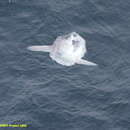ar
الأسماء في صفحات التنقل


Mola is a genus of two species (Mola mola and Mola ramsayi) in the family Molidae, the ocean sunfish. Mola mola is the most common of the ocean sunfish and gave the Molidae their English common name from its habit of "sunbathing" at the ocean surface. Molidae is one of the most recently evolved groups of fishes, descending from reef fish just 40 million years ago and is in the order Tetraodontiformes, which includes puffers and porcupine fish.
Mola grow to be large, with an average size of 1.8m (6ft) and a record size of 3.1m (10ft). They have rough and leathery skin covered with a thick coat of mucus. Their coloration ranges from silvery-gray through spotted to white and they are capable of sudden changes in color in response to unexpected stress, such as predator attacks. Their life span remains unknown.
Mola have a diverse diet and are known to feed at multiple levels in the water column, but they focus on gelatinous floating prey like jellyfish. Mola are infamous for the high count and numerous types of parasites that can be found on any single individual. Their large size allows them some security from predators, but they suffer large losses as bycatch in human fisheries.
Links to lessons for different grade levels can be found at: oceansunfish.org/lessons.php
A sunfish, also called a mola, is any fish in the genus Mola (family Molidae). The fish develop their truncated, bullet-like shape because the back fin, with which they are born, never grows. Instead, it folds into itself as the creature matures, creating a rounded rudder called a clavus. Mola in Latin means "millstone" and describes the ocean sunfish's somewhat circular shape. They are a silvery color and have a rough skin texture.
The mola is the heaviest of all the bony fish, with large specimens reaching 14 ft (4.3 m) vertically and 10 ft (3.0 m) horizontally and weighing over 6,000 lb (2,700 kg).[3] Sharks and rays can be heavier, but they are cartilaginous fish.
Mola are found in temperate and tropical oceans around the world. They are frequently seen basking in the sun near the surface and are often mistaken for sharks when their huge dorsal fins emerge above the water. Their teeth are fused into a beak-like structure, and they are unable to fully close their relatively small mouths.
Ocean sunfish can become infested with skin parasites, so they will often invite small fish or even birds to feast on them. Sunfish will even breach the surface up to 10 ft (3.0 m) in the air, in an attempt to shake the parasites.
They are clumsy swimmers, waggling their large dorsal and anal fins to move, and steering with their clavus. Their food of choice is jellyfish, though they will eat small fish and huge amounts of zooplankton and algae, as well. They are harmless to people, but can be very curious and will often approach divers.
Their population is considered vulnerable,[4] as they frequently are snagged in drift gill nets and can suffocate on sea trash, like plastic bags (which resemble jellyfish, their main food source).
There are currently 3 recognized species in this genus:[5][6]
A sunfish, also called a mola, is any fish in the genus Mola (family Molidae). The fish develop their truncated, bullet-like shape because the back fin, with which they are born, never grows. Instead, it folds into itself as the creature matures, creating a rounded rudder called a clavus. Mola in Latin means "millstone" and describes the ocean sunfish's somewhat circular shape. They are a silvery color and have a rough skin texture.
The mola is the heaviest of all the bony fish, with large specimens reaching 14 ft (4.3 m) vertically and 10 ft (3.0 m) horizontally and weighing over 6,000 lb (2,700 kg). Sharks and rays can be heavier, but they are cartilaginous fish.
Mola are found in temperate and tropical oceans around the world. They are frequently seen basking in the sun near the surface and are often mistaken for sharks when their huge dorsal fins emerge above the water. Their teeth are fused into a beak-like structure, and they are unable to fully close their relatively small mouths.
Ocean sunfish can become infested with skin parasites, so they will often invite small fish or even birds to feast on them. Sunfish will even breach the surface up to 10 ft (3.0 m) in the air, in an attempt to shake the parasites.
They are clumsy swimmers, waggling their large dorsal and anal fins to move, and steering with their clavus. Their food of choice is jellyfish, though they will eat small fish and huge amounts of zooplankton and algae, as well. They are harmless to people, but can be very curious and will often approach divers.
Their population is considered vulnerable, as they frequently are snagged in drift gill nets and can suffocate on sea trash, like plastic bags (which resemble jellyfish, their main food source).